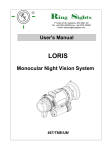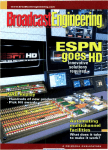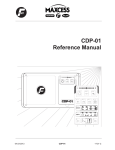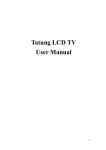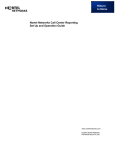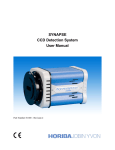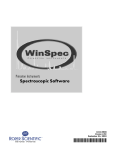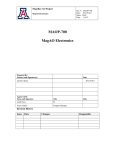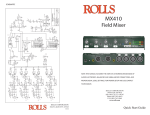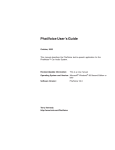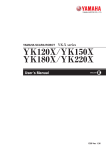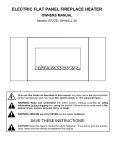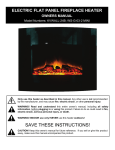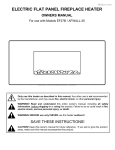Download CCD Driver Assembly
Transcript
i CCD DRIVER ASSEMBLY USER MANUAL CCD CAMERAS CCD DRIVER ASSEMBLY CDB01-x User Manual 11 April 2007 Alan Stummer This manual only applies to the attached pair of boards in the chassis, the Digital and Analog boards. It does refer to the Buffer board (the little one in the vacuum box) and the Headboard (the U-shaped one that actually holds the CCD). This manual does not recognize that the Digital/Analog boards are in a chassis. See Page 4. '© Marconi Applied Technologies Limited 2000.This work must not be copied in whole or in part without the prior written permission of Marconi Applied Technologies Limited.' © Marconi Applied Technologies Limited 2000 1 A1A-CDB01-x Issue 3, 23/03/07 CCD DRIVER ASSEMBLY USER MANUAL Congratulations on buying this high quality Marconi Applied Technologies product! The Marconi Applied Technologies CCD driver assembly facilitates high performance slow scan operation of Marconi Applied Technologies Scientific CCD sensors. It has been designed with as much flexibility as possible and drives most of Marconi Applied Technologies’s CCD02, CCD05 or CCD15 series CCD sensors. High quality, multi-layer PCB’s are used, with separate power & ground planes. The PCB’s are populated with a combination of discrete and surface-mount components, all of good commercial grade. Particular attention is paid to minimise interaction between low level analogue signals and high power digital drive pulses, as well as their associated supply rails. This is achieved by PCB layout, extensive decoupling and individual voltage regulation. All cables are screened and use shielded connectors. Logic generation is achieved by the use of a Field Programmable Gate Array (FPGA, also referred to as ERA). The FPGA draws its code from an EPROM, which contains drive information for 12 Marconi Applied Technologies CCDs. As Marconi Applied Technologies introduces new scientific CCDs, the EPROM is updated accordingly, thus ensuring that the CCD driver assembly provides the most up to date drive waveforms for Marconi Applied Technologies CCDs. The driveboard supplied has the latest issue of EPROM. Future issues of EPROM can be ordered separately as they become available. FEATURES ♦ slow scan operation for very low readout noise ♦ ‘remote head’ for ease of installation ♦ switch adjustment of readout modes ♦ full frame, frame transfer and TDI modes ♦ pixel & line binning ♦ readout rates from 50 kHz to 1 MHz ♦ remote operation via Centronics port ♦ potentiometer adjustment of clock amplitudes, bias, offset etc ♦ link adjustment of CCD sample and clamp timing ♦ generous test points for confirmation of satisfactory operation ♦ synchronization signals for framestore © Marconi Applied Technologies Limited 2000 2 A1A-CDB01-x Issue 3, 23/03/07 ii CCD DRIVER ASSEMBLY USER MANUAL ♦ ramp generation for X Y Z oscilloscope display ♦ matching rack and PSU available ♦ optional setup service for a particular CCD © Marconi Applied Technologies Limited 2000 3 A1A-CDB01-x Issue 3, 23/03/07 iii CCD DRIVER ASSEMBLY USER MANUAL This Manual This manual describes the basic operation of the CCD Driver Assembly, and should provide all the information required to set up the CCD Driver Assembly with any sensor. The reader will need to have familiarity with basic electronic principles to fully understand this manual. The CCD Driver Assembly There are three types of CCD Driver Assembly: CDB01-1, CDB01-2 and CDB01-4; with: one, two and four video channels respectively. The CDB01-1 is described in detail in this manual as it is the most commonly used. The CCD Driver Assembly is used with a sensor and its associated headboard (CHBxx-xx), which must be ordered separately, to make a CCD camera system. A rack (CDR01) with a triple voltage power supply (CDP01) is available so that the system can by powered from the mains. Setting up problems If there are problems when setting up the CCD Driver Assembly which are not covered in this manual, contact MARCONI APPLIED TECHNOLOGIES for technical assistance. Do not change components or modify any circuit boards. The multi layer circuit boards can be easily damaged by incorrect rework. Displaying an image The CCD Driver Assembly is intended for use with a framestore which can capture and display images with high resolution. To help in preliminary assessment however XYZ circuitry is included for picture imaging on an oscilloscope (in XYZ mode). IMPORTANT The CCD Driver Assembly contains static sensitive components: Always observe antistatic precautions when handling the circuit boards of the CCD Driver Assembly - this also applies to the CCD sensor and headboard (CHBxx-xx). For further details see section 1 Anti-static precautions. © Marconi Applied Technologies Limited 2000 4 A1A-CDB01-x Issue 3, 23/03/07 iv CCD DRIVER ASSEMBLY USER MANUAL 1. Anti-static Precautions 1.1. Introduction All circuit boards which make up the CCD Driver Assembly contain static sensitive components. CCD sensors are particularly susceptible to static damage. British standard BS EN100015-1:1992 gives full details on anti-static precautions. These are the basic precautions that must be observed: 1.1.1.Packaging All components are supplied in black anti-static bags, and should be kept in these bags until required. When components are removed from the bags, full anti-static precautions must be observed. When returning components to Marconi Applied Technologies they must be sent in anti-static bags. 1.1.2.Workstation A bench should be set aside as an anti-static workstation, with a bench mat, floor mat, strap to earth and wrist strap. The CDB components should be unpacked, handled and assembled only at the anti-static workstation with the handler wearing the wrist strap. If camera components need to be handled in a remote location the handler must wear a wrist strap attached to earth, and keep the components in anti-static bags where possible. © Marconi Applied Technologies Limited 1......................................................A1A-CDB01-x Issue 3 23/03/07 1 CCD DRIVER ASSEMBLY USER MANUAL Figure 1 – Schematic of Drive Board Assembly © Marconi Applied Technologies Limited 2......................................................A1A-CDB01-x Issue 3 23/03/07 2 CCD DRIVER ASSEMBLY USER MANUAL 2. Introduction to the CCD Driver Assembly The schematic shows the three circuit boards which make up the CCD Driver Assembly and their interconnections. The three boards are described briefly below: 2.1. The Digital Board This board houses the control logic for the CCD sensor and the video processing, and is also responsible for interfacing with the outside world. The Digital Board sends control pulses to the Analogue Board via the 20 way piggyback connector, and to the Buffer Board via the two metre 37 way ribbon cable. The 64 way (a and c) DIN 41612 connector is where power is fed into the CCD Driver Assembly and where the control and synchronisation signals enter and leave. 2.2. The Buffer Board This board terminates the logic signals from the Digital Board to the sensor and amplifies the output signal from the sensor on the headboard. The sensor signal is sent via a miniCOAX cable to the Analogue Board. 2.3. The Analogue Board This board processes the sensor signal from the Buffer Board using correlated double sampling to give analogue video, with adjustable gain. The video signal can be linked to a BNC connector on the front panel or to a pin on the DIN 41612. 2.4. Centronics Program Disk In addition to the three boards mentioned above and the two cables, a disk is also supplied with the CDB. The CDB Menu program enables computer control of camera parameters (described later in this manual). © Marconi Applied Technologies Limited 3......................................................A1A-CDB01-x Issue 3 23/03/07 3 4 CCD DRIVER ASSEMBLY USER MANUAL +5 V F1 DEVICE SELECT SWITCHES +15 V 9 MHz CLOCK EPROM F2 F3 LCL/CMP SWITCH -15 V FRONT PANEL LED TP 19 2 23 3 25 4 24 5 22 8 1 AR 1 ERA CONFIGURE CIRCUIT SWITCH TP 18 AR 2 SW5 B/AR 3 BR 2 31 SWITCHES BR 1 A/B R LATCH ERA DATA CONTROL 12 OFF SHAPER BUFFERS FPGA 10 A 1 INIT 14 A 2 ERROR 11 STATUS, SYNCS DIN 41612 A 3 CONTROL SIGNALS 15 B 1 36 V CHARGE PUMP TP17 TP6 TP7 TP9 TP13 TP20 12 B 2 16 B 3 36 V SUPPLY FIL 1,2 GAIN 1,2 DIFFERENTIAL DRIVERS VR4 PIXCMP, PIXSMP, R, C R DIN 41612 PIXCMP, PIXSMP, R, C R TP 31 33 34 35 36 VEE (-3 V) SENSOR SUPPLIES TP29 VSS VR7 TP28 TP30 VOD VR8 TP32 VR6 0V TP26 VDD VR3 V TP27 VRD VR2 TP21 VOG VR5 VDG VR1 E RA .A P FF G 2 1 Fe br u ary 19 94 Figure 2 – CDB Digital Block Diagram © Marconi Applied Technologies Limited 4......................................................A1A-CDB01-x Issue 3 23/03/07 CCD DRIVER ASSEMBLY USER MANUAL 3. How it works 3.1. Introduction This manual describes in detail how to set the various switches and adjustments on the CCD Driver Assembly. To put the various functions in context it is useful to have an overview of how the camera works. 3.2. The Digital Board The ERA is a field programmable gate array which controls operation of the CCD Driver Assembly and its sensor. A 9 MHz crystal oscillator provides the ERAs master clock. The ERA has to be 'configured' on start up - all its set up data is stored in the EPROM. Four of the EPROMs address lines go to switch 6, hence the data loaded into the ERA depends on the setting of this switch: the control data for the 12 different sensors can be stored in the EPROM. If switch 6 is adjusted, the ERA will need to be reconfigured to load new data. To reconfigure while powered up, use the ‘reset’ switch (switch 5). Switch settings will be discussed in more detail later. The ‘config’ LED on the front panel lights to show that the ERA is configured. To enable the camera to operate in different modes (eg. readout rate, full frame) there are 31 parameter switches connected into the ERA (all but one way of 8 way switches 1 to 4). Parameter access to the ERA is designed so that latched parameter settings can override the switches, under control of the centronics interface (part of the DIN 41612 connector). The ERA supplies pulses to the charge pump circuit which supplies 36 V at a low current for various bias voltage circuits. The various charge transfer (‘ ’) pulses from the ERA are shaped and buffered to the 37 way cable and the buffer board. VR6 sets the upper voltage of all the waveforms. The six CCD bias voltage circuits are on the Digital Board, the presets and test points are shown. When probing the test points hook the probe earth onto one of the six 0 V test points shown. © Marconi Applied Technologies Limited 5......................................................A1A-CDB01-x Issue 3 23/03/07 5 CCD DRIVER ASSEMBLY USER MANUAL Figure 3 – CDB Analogue Board Block Diagram © Marconi Applied Technologies Limited 6......................................................A1A-CDB01-x Issue 3 23/03/07 6 CCD DRIVER ASSEMBLY USER MANUAL 3.3. The Buffer Board Is this just a typo, see 3.4? This board has an amplifier with adjustable gain; links 1, 2 and 3 give gains of 4,8 and 16 3.4. The Buffer Board This board has an amplifier with adjustable gain; links 1, 2 and 3 give gains of 4,8 and 16 respectively. The sensor signal is sent via the SMC connector to the Analogue Board. 3.5. The Analogue Board The sensor signal is processed on the Analogue Board using ‘correlated double sampling’. The first gain stage has adjustable gain via two position switch 1, ‘1’ gives ×1 and ‘0’ gives ×4. A low pass filter follows the first gain stage to filter out pixel frequency noise. When the pixel readout rate is changed the FIL1 and FIL2 lines adjust the low pass cut off frequency. VR5 adjusts the video black level at the pixel rate clamp. The phase of the pixel clamp signal can be adjusted by moving between links 9, 6, 11, 6, 13 and 8. Similarly at the pixel sample stage, phase can be adjusted by moving between links 15, 10, 16, 12, 17 and 14. The gain of the output stage is under control of parameter switch 2 on the Digital Board. Gain can be set to 1, 2 or 4. The output video signal can be linked to the DIN 41612 connector (link 18A) or the BNC on the front panel (link 18B). The X and Y ramp circuits generate line and field ramps for display of an image on an oscilloscope in XYZ mode. The Z amplifier inverts and amplifies the analogue video, suitable for modulating the oscilloscope beam intensity. © Marconi Applied Technologies Limited 7......................................................A1A-CDB01-x Issue 3 23/03/07 7 CCD DRIVER ASSEMBLY USER MANUAL 4. Start up Routine 4.1. Introduction This section of the manual gives an overview to setting up the CCD Driver Assembly and also aims to explain the most rapid route to achieving an image. It only considers the most basic operation ie. fixed settings, un-cooled, full frame operation with visible light. Subsequent sections of the manual go into detail allowing the full flexibility of the board to be utilised. Items supplied with the CCD Driver Assembly ♦ Driver Board consisting of digital and analogue boards ♦ Buffer Board ♦ Two metres of 37 way screened shielded ribbon cable with Cannon “D” connector on each end ♦ Miniature coax cable terminated with SMC connectors either end, two metres long ♦ Manual ♦ Centronics driver program disk Items required to complete an imaging sub-assembly (ordered separately) ♦ Marconi Applied Technologies CCD sensor ♦ Headboard Items of equipment that will be required to set up and run the driver board ♦ Signal generator or timer that will produce a 5 volt pulse equal to the desired integration time. ♦ Lens or other optical arrangement to focus image onto CCD ♦ Shutter arrangement or pulsed illumination (essential for full frame imaging) ♦ DIN 41612 64 way female connector (the CDR01-1 eurocard rack is recommended) ♦ Power supplies, +15 V, +5 V, -15 V (the CDP01 is recommended) ♦ Shutter (or LED) supply ♦ Slow Scan Input Framestore (with built-in ADC) ♦ Oscilloscope ♦ Voltmeter ♦ PC with parallel printer port (optional) Overview of Setup Observe antistatic precautions Unpack boards and cables Do NOT adjust switches or potentiometers on CDB01 if Setup was ordered If Setup option was not ordered, select CCD type, mode of operation and be prepared to adjust the CCD bias voltages for best image ♦ Connect CCD headboard with short ribbon cable to buffer board ♦ Connect CDB01 with two metre, 37-way ribbon cable to buffer board ♦ Connect the front panel BNC on the CDB01 to channel A of an oscilloscope ♦ ♦ ♦ ♦ © Marconi Applied Technologies Limited 8......................................................A1A-CDB01-x Issue 3 23/03/07 8 9 CCD DRIVER ASSEMBLY USER MANUAL ♦ Connect line drive/line sync on the 64-way DIN41612 to channel B of the oscilloscope ♦ Trigger off channel B ♦ Focus an image with light level of about 50 millilux on the CCD ♦ If at all possible, operate the CCD in frame transfer mode ♦ Connect DIN41612: apply power to CDB01 - look for green LED on CDB01 front panel ♦ Observe the waveform on channel A of the oscilloscope. This should have an amplitude of about 0.5 to 2.0 V peak-peak, with modulation corresponding to the scene being imaged ♦ Connect video, frame, line and pixel clocks to framestore - obtain image on computer 4.2. Power Supply Requirements The power supply must be a linear regulated type - do NOT use a switched mode type. Parameter 5V +15 V -15 V 5.0 to 5.2 +15.0 to +15.5 -15.0 to -15.5 Typical current (mA) 200 600 200 Peak current (mA) 400 1200 400 PSU current limit (A) 1.0 1.5 1.5 Maximum ripple (mV) 3 5 5 Voltage (V) 4.2.1.Connection of Power to CDB01-1 Driver Board A DIN41612 64-way socket, (rows A and C) is required. The pinout of this connector is shown in Appendix B. Power rails are input on pins 28 to 32 rows A and C. 4.3. Positioning the camera head The camera head is in two parts, the CCD Headboard and Buffer board. Each type of CCD has a unique Headboard but the Buffer board is common to all types of CCD. The Headboard may be mounted within the optical system by the mounting holes as shown in Appendix H, which also shows the position of the CCD centre and focal plane with respect to all of the CCD boards. The Buffer board is also fixed by mounting holes as shown in Appendix H. It is connected to the CCD board by a 26 way ribbon cable and must be not more than 50 mm from the CCD board. Prior to mounting the Buffer board it is recommended that gain of the buffer amplifier be set by selecting the appropriate link. Channel 1 © Marconi Applied Technologies Limited Link LK4 LK5 Gain 4 8 Comments 9......................................................A1A-CDB01-x Issue 3 23/03/07 CCD DRIVER ASSEMBLY USER MANUAL 2 3 4 LK6 LK1 LK2 LK3 LK10 LK11 LK12 LK7 LK8 LK9 16 4 8 16 4 8 16 4 8 16 This channel normally used for low noise output This channel normally used for low noise output For a single output device CHANNEL 2 of the headboard will be connected to Channel 1 of the Analogue board. For CCD15 series all outputs are low noise. Set gain as appropriate for device type. Devices having large pixel area will require a lower gain setting. In any case, the gain should be chosen to ensure that the video input level to the Analogue board does not exceed 5 volts when the CCD output is saturated. Do not connect headboard to digital board at this stage. © Marconi Applied Technologies Limited 10.....................................................A1A-CDB01-x Issue 3 23/03/07 10 CCD DRIVER ASSEMBLY USER MANUAL 4.4. Pulsed or Shuttered Illumination When using full frame CCDs, the issue of whether or not to use pulsed or shuttered illumination must be considered. In practice, this only becomes essential when the readout time is longer than the integration time. In many cases, particularly when the dark current in the CCD is limited by the use of an inverted mode CCD, and/or the use of an external Peltier cooler, the integration time can be made relatively long. In this case, the readout time, especially if 1 MHz rate is used, may be at least a factor of three shorter than the integration time. Whilst there will be some evidence of frame shift smear, the resultant image will be very usable. Accordingly, pulsed or shuttered illumination is often not required, although for the best results, instructions on how to achieve this is given below. If illumination is provided by an artificial source then it might be appropriate to pulse this source using a circuit similar to that shown below. Where the scene is naturally illuminated it will be necessary to place a suitable shutter between CCD and scene. In order to be compatible with the board, the scene should be illuminated or the shutter open when the input to the illumination control is high. It is advantageous (to prevent feed through of spikes onto the driver board) to power the shutter/light source from a separate supply and use a buffer from 5 volt CMOS to the shutter supply. A suitable circuit for shutters that consume up to 1 amp at between 5 and 25 volts is shown below. Figure 4 Shutter Buffer Timing The shutter/light source must be synchronised to the CCD Driver Assembly. For initial evaluation purposes it is acceptable to connect the input of the shutter control to Pin 19C on the 64 Way DIN 41612 connector on the rear of the digital board. In this configuration the integration time must be at least 10 times greater than the shutter's response time. (Typically 20 ms for a mechanical shutter.) See Appendix B for a list of inputs and outputs on the DIN 41612 connector. Pin 19C is Start Integration and goes high for the duration of integration. Under normal operation it closely follows the level of Request for Integrate (Pin 20C), the timing input to the board. © Marconi Applied Technologies Limited 11......................................................A1A-CDB01-x Issue 3 23/03/07 11 CCD DRIVER ASSEMBLY USER MANUAL 4.5. Power supplies All power supply voltages should be ± 2% of the stated value, and free of ripple +5 volts at 400 mA to pins 29A & 29C When the board is turned on or reset, it consumes up to 1 amp at 5 volts for up to 30 ms during reconfiguration. At all other times, regardless of mode of operation, the power consumption is as stated. +15 volts at 500 mA to pins 28A & 28C During frame transfer the board consumes up to 2 amps at 15 volts for the duration of the frame transfer. Current demand also increases as the number of binned lines is increased, up to a maximum of 2 amps when 256 lines binned -15 volts at 300 mA to pins 30A & 30C Power supply ground to pins 32A & 32C It is important to ensure that either all supplies are connected simultaneously, or +5 volts applied first. 4.6. Select device and set bias supplies The board set up includes the selection of CCD type, drive mode and adjustment of all DC supplies to the CCD. Use Switch row 6 to select the type of CCD that is being driven, eg, CCD 05 - 30, 02 06 etc. See Appendix D for CCD types and their respective switch positions. Refer to Appendix C for setting of the switch array (Switch rows 1 - 4). The switches may be set directly or remotely by a PC with the software provided. For initial operation it is best to set the switches manually and then change them as desired using the remote selection. If the remote selection is to be used the typical suggested initial manual settings are: Line and pixel binning. (Rows 3 and 4) All switches set to 0 or off. Directions and Gain. (Row 2) Set switches e & f to 1 or on, Set rest of row to 0 or off. Readout rate and mode of operation. (Row 1) Switches set as required. Now that the CCD type and mode of operation have been selected all of the DC supplies need to be checked and if necessary, adjusted to the requirements of the selected CCD before the board can be connected to the headboard and CCD. Turn on the power to the board. The supplies should be switched on simultaneously or 5 volt supply first. © Marconi Applied Technologies Limited 12.....................................................A1A-CDB01-x Issue 3 23/03/07 12 CCD DRIVER ASSEMBLY USER MANUAL When the 5 volt supply is turned on check to see that the green LED on the front panel is illuminated. This confirms that the ERA has configured correctly. See troubleshooting if LED does not light. Refer to appendices F G and H, for a list of bias adjustments, testpoints and potentiometers, and for the location on the board of the test pins and potentiometers. The set voltages may be double checked for the correct setting at the respective pin on the 37 way connector to the headboard. Not all of these potentiometers will need to be set, i.e. VDG is only required on a few devices i.e. on the CCD 25 series and VCP is set at 36 volts and must not be adjusted. At this stage only the voltages listed in Appendix G can be set. Going around the bias points as listed, connect a voltmeter across the test pin listed and TPs 31, 33, or 34 (Ground) and rotate the respective potentiometer until the desired voltage is reached. Once all bias voltages are set turn off the power to the board. If the remote switch selection is to be used connect the parallel printer port of a PC to pins 1 to 13A and 1 to 13C of the DIN 41612 via 25 way ribbon cable where pin 1 of the 25 way Cannon 'D' corresponds to pin 1C on the DIN 41612, pin 2 corresponds to pin 1A, 3 to 2C etc. One method of connecting the 25 way ribbon cable to the DIN 41612 is to use a 41612 socket with wire wrap pins (soldered through a backplane) and terminate the 25 way ribbon cable with a 26 IDC backplane connector manufactured by 3M and supplied by ESD. To operate software turn on computer and CDB, connected as above. Insert supplied disk into drive, select that drive and type CDB. You will be presented with a list of options. Use cursor keys to select option and return to toggle option. When settings are as desired place cursor on send and press return. © Marconi Applied Technologies Limited 13.....................................................A1A-CDB01-x Issue 3 23/03/07 13 CCD DRIVER ASSEMBLY USER MANUAL 4.7. Integration control pulse Do not allow the output of the signal generator in to the digital board go high if the board is not powered as this may result in damage. Connect output of a signal generator/timer between pins 20C on the DIN 41612, request for integration and pins 32A & 32C, ground. The clock into the board must be either TTL or 5 volt CMOS. The board will start integration on the rising edge of this pulse and commence readout on the falling edge. ie. The integration time of the CCD is equal to the high duration of the clock from the signal generator. The clock should then be held low long enough for the CCD to be read out. If the request for integration line is taken high before the CCD has been read out then the rising edge is ignored until the board has completed out the last frame. The readout time for the CCD can be calculated from the CCD data sheet or from Appendix E, using the following approximate equation. TRO = where: TRO L P BL RR = = = = = L x ( P + 3) ( BR x RR ) Readout Time. Total number of lines on CCD (Vertical Elements) Total number of pixels in Readout Register No of binned lines. ie. 1 for no binning, 2, 3 etc. Readout Rate. Alternatively the readout time can be monitored at the Grab output from pin 18C of the DIN 41612, which is LOW during readout of the CCD. The actual integration time can be monitored at pin 19C, start integrate, which is HIGH during integration. This pulse will normally be the same width as request for integrate (Pin 20C) unless request for integrate is high during the readout of the CCD, in which case start integrate, and hence integration interval, will be shortened. 4.8. Connect buffer board & headboard to digital board Now that all of the bias voltages have been checked and board connected to integration control pulse, turn off the power to the board and connect the headboard. The two are connected by up to 2 metres of 37 way screened ribbon cable and 1 to 4 RG174 coaxial cables, one cable per video channel, each up to 2 metres long. 4.9. Set video pedestal and gain on the Analogue Board Setting up of the analogue board involves setting the gain of the video processing such that the video output is of the desired level and adjusting the pedestal or voltage to which the reset level is clamped. The gain is set at three stages of the video path. First the buffer board, then the input to the CDS circuit and finally the output stage of the CDS circuit. The gain of the output stage may also be adjusted remotely. © Marconi Applied Technologies Limited 14.....................................................A1A-CDB01-x Issue 3 23/03/07 14 CCD DRIVER ASSEMBLY USER MANUAL The following operations will need to be performed on each video channel used, apart from setting final stage gain which is common to all channels. Note that the Z output for XYZ operation is only available on channel 1. Gains of ×4, ×8 or ×16 are available on the buffer board, and should have been set previously as indicated in paragraph 1 - positioning of the headboard. Switch 1 provides gains of ×1 or ×4 at the input of the CDS circuit and the two gain switches on the digital board provide gains of ×1, ×2, ×4 or ×8 at the output of the CDS circuit. Turn on power to the system. ie. Board, signal generator and illumination/shutter, so that the system is operating as desired. Connect a scope probe between test pin 1 (video signal) and test pin 20 (Ground). See Appendix F for location of test pins, on boards and in the circuits. With the CCD under peak predicted illumination, check the video amplitude at TP1. Trigger the oscilloscope from either edge of the pixel clock (Pin 15C) The waveform you should expect to see during readout is shown here. Figure 5 – CCD Output Waveform This best represents the waveform at 50 kHz readout rate. At higher frequencies it becomes more rounded. The mean reset level at TP1 should be 0 volts. The difference in signal level and reset level, the signal, at TP1, is influenced by all of the following variable elements. Incident illumination at CCD Lens aperture Intensity of light source Integration time of CCD Gain set on buffer board Gain set at switch 1 on analogue board All of the above should be adjusted to set the signal at TP1 to the desired level of video up to a maximum of 5 volts. It is possible that there will not be enough light available to achieve the desired output video amplitude at the preferred integration interval. In this © Marconi Applied Technologies Limited 15.....................................................A1A-CDB01-x Issue 3 23/03/07 15 CCD DRIVER ASSEMBLY USER MANUAL case set the gain on the buffer board to ×16 and the gain at switch 1 of the analogue board to ×4. The amplitude of the reset feedthrough spikes is not important as the analogue board is designed to cleanly clip anything over 5.3 volts. Connect an oscilloscope to the output of the analogue board. (BNC connector J5) Use the final stage gain switches (switches e and f in row 2 of the switch array) to adjust the amplitude of the output video to the desired level up to a maximum of 10 volts. For levels in excess of 1 volt peak this output must not be terminated at the ADC/framestore. Now the pedestal should be adjusted. Use the output from pin 17 C to trigger the oscilloscope which should still be connected to the output of the analogue board. Ensure that the CCD is not illuminated. Adjust the pedestal pot listed in Appendix F until the video output is at 0 volts or desired pedestal. This is best done using the dark reference elements. The dark reference elements are those that are read out while line clamp is high. This will be two or three pixels at the start of each line for 05 series CCDs. Checking of Dynamic Range Set link 18 of the analogue board to route the video output to the BNC socket on the front panel. Connect the BNC via a 50 ohm coaxial cable to the channel 1 input of an oscilloscope using a 'T' piece, and 50 ohm termination resistor. Connect a scope probe to channel 2 and attach this to pin 15C (pixel clock) of the 64 way DIN connector. Trigger the scope from channel 2. Illuminate the CCD to saturation level and note the amplitude, in volts, from ground to the peak of the output. See figure 5. Blank off the CCD from all illumination and on the most sensitive range of the scope note the peak to peak amplitude of the noise. Dynamic Range = 6 x peak output pk − pk noise 4.10.Connection of board to Display Device The resultant video may be put into an ADC/frame store or the XYZ of an oscilloscope or suitable monitor. The choice of display device will depend on whether the intended use needs to generate a two dimensional image, or provide video data direct into a microcomputer (machine vision) or merely provide an output voltage proportional to light input (as is the case when the CCD is used to replace a photomultiplier, for instance). In all cases, a slow scan input frame store will make best use of the video from the driver board assembly. However, where imaging is not required in the final application, and to save the cost of a framestore, the driver board can generate a set-up grade image on an XYZ oscilloscope. 4.10.1.Output to a Framestore Refer to Appendix B to decide which outputs on the DIN 41612 connector may be suitable for use with the chosen frame store. The relevant pulses for framestore use are listed under "Sync Pulses". Refer to section 3 for an © Marconi Applied Technologies Limited 16.....................................................A1A-CDB01-x Issue 3 23/03/07 16 17 CCD DRIVER ASSEMBLY USER MANUAL explanation of each clock output waveform, and timing diagrams. Typically the framestore will require 3 timing pulses: 18C Grab Frame Clock & Blanking 17A Blank Line Clock & Blanking 15A&C C Pixel Clock Low During Active frame Low During active line Active High, both edges valid Each video channel has an output impedance of 50 ohms. It may be necessary to include a line clamp. This is a pulse on pin 17C that is high during the readout of dark reference elements at the start of a line of video. Use supply ground as a signal return for the above signals. Turn on all power to view image. When turning on power to the system, always turn on the board before any inputs to the board (except computer interface). 4.10.2.Output to an Oscilloscope The X, Y and Z outputs will need to be adjusted. Refer to Appendix F for locations of potentiometers to adjust. Connect X and Y outputs to oscilloscope. Ensure that links 1,3,4 and 5 are in place. Turn on power to the board. To set the X ramp, hold the input from the signal generator, request for integrate, low. Look at the output from X on the scope. Use either edge of line blank (Pin 17A) to trigger the oscilloscope. The trace observed on the oscilloscope should resemble that in figure 6. Line/Frame Duration Line f ra m .1 FFG 1 3 Ap ril 1 994 Figure 6 – Output from X and Y Adjust potentiometer VR1 such that the amplitude of the waveform is around 8 to 10 volts. To adjust Y, the signal generator must be set to provide Request for Integration input pulse to stimulate the board to readout the CCD. For this purpose set the output of the signal generator to a rate in the order of 10 Hz, 50% duty cycle square wave. The traces produced should resemble those shown for X ramp as in figure 3, but having a longer duration (TRO as calculated earlier). Use the falling edge of © Marconi Applied Technologies Limited 17.....................................................A1A-CDB01-x Issue 3 23/03/07 CCD DRIVER ASSEMBLY USER MANUAL grab to trigger the oscilloscope. Adjust potentiometer VR 2 such that the peak voltage of the waveform is around 8 to 10 volts. For longer readout times move the header from link 1 to link 2. This reduces the rate of increase in voltage on the Y ramp thus making adjustment easier, using the same potentiometer. The Z axis output will need to be set. This output is tailored for the beam modulation control inputs for oscilloscopes, hence the Z output is inverted video with a large positive offset. While there is still no illumination on the CCD, adjust VR6 so that the voltage at the output of Z is equal to the trace blanking voltage for the oscilloscope. Illuminate the CCD at normal operational level and adjust VR5 (Z amplifier gain) so that the peak video signal just goes down to 0 volts. If there is insufficient gain, increase the gain at the final stage of the CDS board. This output is now ready to be connected to the beam modulation input of the scope. To use the oscilloscope to view an image, connect X to X channel on scope, Y to Y and Z to beam modulation input. Switch the scope to XY mode. Set the sensitivity of X and Y channels on scope to 1 volt per division. Adjust X and Y position controls and trace intensity until image is central on scope screen. This method of viewing does not maintain the aspect ratio of the image. It may be restored by adjusting the X and Y channel sensitivities on the scope. 5. In Depth Circuit Description and Operation This section of the manual describes in detail the operation of the digital board and analogue board. Function and operation of the head board assembly is described in the next section. This section is split into the following subsections. Power Supplies A brief description of power supply requirements. DC Bias Supplies This subsection describes how to optimise the performance of the CCD using the bias supplies. Mode selection Describes the modes of operation that are available and the switch array settings required to select the mode of operation. © Marconi Applied Technologies Limited 18.....................................................A1A-CDB01-x Issue 3 23/03/07 18 CCD DRIVER ASSEMBLY USER MANUAL DIN 41612 Backplane connector Describes all the control lines present at the 64 way connector and their uses. This covers all the inputs required by the board for correct operation and outputs that may be used to synchronise the video output of the board to the receiving system. Video Processing Describes the video processing and how to adjust the output video to that required by the receiving system. 5.1. Power Supplies The power requirements of the board are: +15 ± 0.5 volts, ripple free, at a maximum of 1 amp + 5 ± 0.2 volts, ripple free, at a maximum of 1 amp -15 ± 0.5 volts, ripple free, at a maximum of 0.5 amp It is important to ensure that either all supplies are connected simultaneously, or +5 volts applied first. All power supplies must be regulated and have a low impedance path to the board. The digital board is fitted with fused over voltage and reverse voltage protection. If the board is incorrectly connected to the power supplies, then the fuse and input protection diode will need to be replaced for that supply. All power supplies are filtered for HF noise at the input of the board. 5.2. DC Bias Supplies The correct voltages must be set prior to connection to the CCD Headboard. Failure to observe this precaution may result in irreparable damage to the CCD. The digital board provides adjustment for all of the voltages required for correct operation of the CCD, including clock amplitudes. Since the board will support many different variants it is necessary to ensure that the set voltages are appropriate for the CCD in use. The regulated 36 volts that powers some of the DC supplies is factory set and should not be adjusted. The remainder of the supplies may be set in any order. VOD CCD Output transistor drain bias voltage. This voltage is not critical for optimum performance of the CCD. It should be at least 5 volts higher than VRD. Set to value in data sheet ± 0.5 volt. VDD Diode drain bias voltage. The diode drains are positioned at the extremities of the active part of the CCD. They drain away any surplus charge generated at the edges of the active array and any spurious charge generated in the silicon around the active part of the CCD. Voltage level not critical. Set to value in data sheet. © Marconi Applied Technologies Limited 19.....................................................A1A-CDB01-x Issue 3 23/03/07 19 CCD DRIVER ASSEMBLY USER MANUAL VSS Substrate Supply. This is the voltage to which all other voltages on the CCD are referenced. This voltage has a significant effect on the performance of the CCD. Set initially to the figure in the data sheet. This voltage may be optimised once a CCD is present and running. Increasing this voltage reduces dark current but will ultimately reduce charge transfer efficiency. Excessive voltage also reduces full well capacity (i.e. Output signal). To set the optimum level for Vss: Remove illumination from the CCD and adjust Vss to bring the level of the dark reference pixels at the start of each line of video as close as possible to the blank elements at the start of each line. Then illuminate the CCD and adjust integration interval or source brightness until the video output is just about to saturate. Increase Vss until the picture just begins to smear. Reduce Vss slightly so that the smearing just stops. Repeat these adjustments as necessary until a satisfactory balance is achieved. VRD Reset drain bias voltage. This is the voltage to which the gate of the output transistor is set to after the previous pixel has been read out. Adjusting this voltage will have a significant effect on the performance of the CCD as it determines the working point of the output transistor. If the set voltage is too high or low then the gain of the output transistor will not be at it's maximum. Set initially to the voltage in the data sheet and then adjust to obtain peak output from the CCD (for constant illumination), whilst also optimising limiting resolution. VOG Output gate bias voltage. This supplies the output gate, which lies between the end of the readout register of the CCD and the base of the output transistor. It reduces the feedthrough of the clock signals on the readout electrodes to the output transistor. The voltage is not critical. Set to value in data sheet. VR Readout electrode voltage swing. Setting this voltage too high increases dark current in standard mode devices. It also increases power consumption and clocking noise onto the output. Setting VR too low reduces charge transfer efficiency resulting in smear of the image. Set to voltage in data sheet. VDG Dump gate voltage. This is only used in a few devices. If not used ignore this voltage, alternatively set to voltage in data sheet. © Marconi Applied Technologies Limited 20.....................................................A1A-CDB01-x Issue 3 23/03/07 20 CCD DRIVER ASSEMBLY USER MANUAL SW5 (On front panel) Switch 1 Switch 2 Switch 3 Switch 4 SW6 FT/ FF STD/ INV READ RATE 1 READ RATE 2 READ RATE 3 STD/ TDI COMP/ LOCAL STD/ XRAY ON a b c d e f g h OFF A DIR B DIR R DIR1 R DIR2 GAIN 1 GAIN 2 NOT USED NOT USED ON a b c d e f g h OFF SW1 SW2 L.S.B. M.S.B. ON SW3 a b c d e f g h OFF BINNED PIXELS L.S.B. M.S.B. ON SW4 a b c d e f g h OFF BINNED LINES S W IT CH E S. 1 F FG 13 A p ri l 1 9 94 Figure 7 – Switch Positions 5.3. Mode Selection Once the CCD type has been selected using switch 6, the selection of mode can be achieved either locally by the use of switches as above, or remotely by the use of the Centronics driver program provided. The choice of local or remote mode must therefore first be set by the position of switch 1g. Remote Mode (Centronics Driver) Connect Centronics (parallel printer) port via a suitable 25 way screened cable to pins 1 to 13 of the 64 way DIN connector on the driver board. Under DOS, load floppy disc and type 'CDBMENU'. The display will show the list of modes that can be toggled, as well as gain, readout rate and binning values that can be set. All switch settings from SW1a to SW4h, except SW1g can be set remotely. Local Mode All switches are located on the digital board, and are shown in outline in figure 7. Each mode of operation is explained below with reference to the switch number. Appendix C also gives an explanation of the switch arrays. © Marconi Applied Technologies Limited 21.....................................................A1A-CDB01-x Issue 3 23/03/07 21 CCD DRIVER ASSEMBLY USER MANUAL SWITCH 1a: FRAME TRANSFER/FULL FRAME 0 : Full Frame This mode of operation uses the whole area of the CCD to collect light from an image. Once the CCD has been exposed for the required integration interval illumination must be removed. The image may then be read out. In this mode the user is required to provide an input to control integration interval. Integration is controlled by pin 20C on the DIN 41612 connector, ‘Request for Integration’. When this pin is held high all the clocks in the image area of the CCD are stopped and the CCD collects charge. While the CCD is integrating an image the readout registers are continuously closed to keep them free of accumulated dark current. As soon as ‘Request for Integration’ is taken low, the first line of the image is shifted into the readout register and the line is read out. Successive lines are readout until the whole frame has been transferred. If ‘Request for Integration’ is taken high before readout of the frame is complete, it is ignored until readout is complete. At completion of readout, if request for integrate is still high, the CCD will start integration as normal. continuously clocked to keep the CCD free of dark current. When ‘Request for Integration’ is held low and an image is not being read out, the image section of the CCD is In order to avoid vertical smearing of the image, the CCD must not be illuminated during image read out. SWITCH 1a: FULL FRAME/FRAME TRANSFER 1 : Frame Transfer This mode of operation uses half of the active area of the CCD for imaging. At the end of integration the stored image is moved down to the bottom half of the active area for readout. While this image is being read out the top half of the CCD is integrating the next image. To use this mode of operation, one half of the CCD will need to be masked. No shuttering is required for this mode. Integration is controlled by pin 20C on the DIN 41612 connector, ‘Request for Integration’. When this pin is held low, the CCD free runs. i.e. The image area integrates for the time it takes to read out the store section of the CCD. At completion of readout, the charge accumulated in the image area is transferred to the store section for readout. After frame transfer, the image section continues integrating. i.e. In frame transfer mode with ‘Request for Integration’ held low, integration and readout are almost continuous, only punctuated by frame transfers. © Marconi Applied Technologies Limited 22.....................................................A1A-CDB01-x Issue 3 23/03/07 22 CCD DRIVER ASSEMBLY USER MANUAL The minimum integration time is set by the time it takes to read out the store section. The integration time of the image section may be extended by holding ‘Request for Integration’ high. Integration will continue until ‘Request for Integration’ is taken low, at which point frame transfer will be initiated. At completion of frame transfer the CCD will revert to normal integration. If ‘Request for Integration’ is held high and read out of the previous frame is complete the store section will be continuously clocked to keep it free of dark current. SWITCH 1b: STANDARD/INVERTED MODE OPERATION 0 : Inverted Mode Operation This mode of operation should only be selected if the system is driving an inverted mode CCD. In this mode all the electrodes in the image area of the CCD are held LOW during integration. In inverted mode devices this reduces dark current, allowing longer integration times without cooling the CCD. Using this mode on standard devices will allow charge to distribute itself evenly over the active area of the CCD resulting in complete loss of the image. 1 : Standard Mode Operation This mode of operation may be used with any device, but will increase dark current in inverted mode devices. In this mode one in every three electrodes in the image area is held high. The charge generated from integration is stored under this electrode. SWITCHES 1c, d, e: READOUT RATE. These three switches select the rate at which pixels are read out of the readout register. The rate set is independent of any other features. See Appendix C for settings. SWITCH 1f: STANDARD/TIME DELAY INTEGRATION 0 : Time Delay Integration This mode of operation is designed to allow extended integration of moving images, allowing charge to be moved across the image area of a CCD at the same rate as the image. TDI only works in full frame, hence when TDI is selected the setting of switch 1a is ignored. In this mode of operation the CCD is normally integrating. The image is read out line by line on request. © Marconi Applied Technologies Limited 23.....................................................A1A-CDB01-x Issue 3 23/03/07 23 CCD DRIVER ASSEMBLY USER MANUAL The line readout is controlled by pin 20C on the 64 way DIN 41612 connector. Every time that this pin receives a rising edge one line is transferred to the readout register and read out. If ‘Request for Integration’ is held high or low the CCD will just continue to integrate. While the readout register is being read out all rising edges to ‘Request for Integration’ are ignored. Great care must be observed when using this mode of operation to avoid loosing an image due to over loading the CCD with dark current. There is no inherent charge clearing so dark current will be accumulated until ‘Request for Integration’ is switched. If the driver board is switched on in this mode or the CCD has not been read out for a short period before commencing integration then some arrangement should be made to clear the CCD of accumulated charge. Two suggested methods, both with the CCD in darkness are: 1) Switch the driver board to normal mode of operation for at least 2 seconds or until ready to start integrating with ‘Request for Integration’ held low. 2) Supply ‘Request for Integration’ with at least as many pulses as there are lines to clear the CCD of charge and then keep pulsing for time delay integration. SWITCH 1f: STANDARD/TIME DELAY INTEGRATION 1 : Standard integration As selected in other modes of operation. SWITCH 1g: LOCAL/COMPUTER 0 : Local Mode of operation set by switches on board. 1 : Remote/Computer Allows remote setting of the functions in the switch array by the computer interface on pins 1 to 13 on the 64 way DIN 41612 connector. If computer is not present, then the board reverts to the settings on the switches. The computer interface is based on a Centronics port and will accept data from the parallel printer port of a PC. SWITCH 1h: STANDARD/X-RAY This switch should be set to 1 for visible light and infra red light incident on the CCD and to 0 for X rays. When set for visible illumination, the line clamp pulse on pin 17C on the DIN 41612 connector, goes high for the central two pixels on the dark reference elements at the start of each line. When switched to X ray illumination, the line clamp pulse is moved to the blank elements before the dark reference elements at the start of each line. © Marconi Applied Technologies Limited 24.....................................................A1A-CDB01-x Issue 3 23/03/07 24 CCD DRIVER ASSEMBLY USER MANUAL SWITCHES 2a, b, c, d These switches set the direction of movement of charge in both halves of the image section and readout registers. This allows the image to be read out to any corner of the CCD, two opposite corners or all four corners of the CCD simultaneously. The number of options available is dependent on device type. 05-11, 15-11 and 02-06 have only one output. 05-*0 series devices have four outputs, two high speed and two low noise. These devices do not have split readout registers hence only up to two outputs may be used at any one time. Selecting readout direction gives the choice of using either high speed or low noise output. 15-*0 series devices have four identical low noise outputs with split readout registers hence 1, 2 or 4 outputs may be used at any one time. With split readout, for example to two opposite corners of the CCD, the image is split in two for readout, hence halving readout time. The image must then be reconstituted within the framestore. SWITCHES 2e, f: GAIN 1 & 2. These are the final video processing stage gain selection switches for the analogue board. SWITCHES 3a-h: BINNED PIXELS. The setting of this row of switches determines the number of binned pixels. This allows improved sensitivity, but will result in reduced horizontal resolution. To set the number of binned pixels: 1 Subtract 1 from the desired number of binned pixels. 2 Convert this number to binary 3 Set the row of switches according to the binary result, where switch 1 corresponds to the LSB. Example: Require 6 binned lines. Subtract 1 - Left with 5 5 as a binary number is 0000 0101 Set switches such that switch 1 is at 1, switch 2 is at 0, switch 3 is at 1, etc. There is no binning when all switches set to 0. © Marconi Applied Technologies Limited 25.....................................................A1A-CDB01-x Issue 3 23/03/07 25 CCD DRIVER ASSEMBLY USER MANUAL Increasing the number of binned pixels does not affect the total readout time of the CCD. The charge is still clocked along the readout register at the same rate, but the output of the CCD is reset less often as binning increases. Figure 8 illustrates this. Figure 8 – The Effect of Pixel Binning Pixel binning will normally be applied at low levels of illumination. As illumination levels increase care must be taken not to over load or saturate the output gate of the readout register. Consult CCD data sheet for maximum number of binned full pixels. SWITCHES 4a-h: BINNED LINES. The row of switches is set as for binned pixels. Increasing the number of binned lines reduces total readout time. If two lines are binned the readout time will be approximately halved as will the number of lines read out. Vertical resolution will be reduced. Increasing binned lines increases the line blanking period as more lines have to be transferred to the readout register in this time. Figure 9 shows the effects of line binning. © Marconi Applied Technologies Limited 26.....................................................A1A-CDB01-x Issue 3 23/03/07 26 CCD DRIVER ASSEMBLY USER MANUAL Line Blank No Line Binning Line counter Line Blank 2 Lines Binned Line counter Figure 9 – Effects of Line Binning When binning lines care must be taken not to overload the readout register. Overloading the readout register results in horizontal smear of the image. 5.4. DIN 41612 Backplane Connector Pins 1 to 13 Centronics Computer Interface These pins may be connected directly to a Centronics printer port via a 25 way ribbon cable. See section 5.3. Pins 15 - 18 : Framestore interface Pins 15A & 15C Pixel Clock These two pins are differentially driven. The outputs can be fed into a differential line receiver such as a 26C32. Alternatively one pin may be used as a normal 5 volt CMOS output. Pin 15A is effectively inverted pixel clock and pin 15C the true output as would be seen at the output of a line receiver. Pixel clock is a 200 ns pulse that occurs once for every pixel read out of the CCD. It is high during the valid portion of each pixel in the video output from the analogue board. It should be used as a sample window when digitising the video output and as the clock for framestores that require one clock pulse per pixel. For edge triggered systems, either edge may be used as both edges of the pixel clock are during valid video output. Figure 10 illustrates this. © Marconi Applied Technologies Limited 27.....................................................A1A-CDB01-x Issue 3 23/03/07 27 CCD DRIVER ASSEMBLY USER MANUAL Figure 10 – Timing of Pixel Clock and Continuous Clock Pin 17A Line Blank Line blank is a pulse that occurs once every line read out from the CCD. It may be used as a line clock. It is LOW during the output of active video. It is HIGH during line transfer, readout of blank elements, dark reference elements and transition elements. Line blank is used to identify active video at line rate. Line blank continues to operate when dark current is being cleared from the CCD, so for full frame and frame transfer modes of operation it should be used in conjunction with GRAB to identify active lines. Figure 11 shows the timing of line blank. Pin 17C Line clamp Line clamp occurs once per line. It is active high for 2 to 3 blank or dark reference pixels at the start of each line. It identifies the black level of the video output of the analogue board. In AC coupled systems it is used to restore the output video black level at the start of each line. Figure 11 shows the timing of line clamp. Pin 18A Line counter Line counter is a pulse between 500 ns and 1 µs long that occurs once for every line transferred to the readout register of the CCD. When there is no binning this pulse may be used as a line clock. When lines are binned, it can be used to count the number of lines binned. i.e. the number of line counter pulses that occur per line of video read out, at the start of the line. Figure 11 shows the timing of line counter. © Marconi Applied Technologies Limited 28.....................................................A1A-CDB01-x Issue 3 23/03/07 28 CCD DRIVER ASSEMBLY USER MANUAL Figure 11 – Line Counter, Blank and Clamp Pin 18C Grab Grab is used to identify active video from the CCD. During the interval between completion of frame readout and the start of integration in the full frame mode of operation, the image area of the CCD is read out as normal to keep the CCD free of dark current. The grab output will enable the user to ignore this spurious output. Grab is LOW during the readout of active lines. Grab is HIGH at all other times. In TDI mode Grab is held LOW as all lines read out are potentially active. Figure 13 Shows the timing of Grab in full frame and frame transfer modes. Pin 19A Configured This pin duplicates the function of the Config LED on the front Panel. This pin is LOW if the ERA has configured correctly. The LED should also be on. This pin is HIGH if the ERA has failed to configure. The LED will be off. In this case the Reset push button on the front panel should be operated, or power supplies could be cycled off/on. Pin 19C Start Integration This pin returns the integration state of the CCD. This pin is HIGH when the CCD is integrating. It is most useful in full frame mode of integration. It may be used to synchronise the illumination of the CCD so that the CCD is not illuminated while reading out. It may also be used to check the actual integration time of the CCD in both full frame and frame transfer modes of operation. If ‘Request for Integration’ is taken high during the readout of the CCD the CCD will not start to integrate until readout is complete. In this case integration time will be reduced, but this will be reflected by the length of the start integration pulse. © Marconi Applied Technologies Limited 29.....................................................A1A-CDB01-x Issue 3 23/03/07 29 CCD DRIVER ASSEMBLY USER MANUAL In synchronising a shutter with the board it is important that no light falls onto CCD during readout. Therefore the shutter must be completely closed before readout is started and must not be allowed to open again until readout is complete. The circuit shown in figure 12 will not allow the shutter to be open during any readout time. The integration control is high for the desired integration time. The Delay circuit delays only the falling edge of the integration control pulse by the length of time it takes the shutter to close. This ensures that the board does not commence readout before the shutter is completely shut. The shutter control is gated with Start Integration so that the shutter cannot open while Start Integration is low. ‘Start Integration’ may also be used to extend integration interval in Frame transfer mode. The rising edge may be used to trigger a monostable whose output is fed to ‘Request for Integration’ to determine the integration interval. The monostable period must always be longer than the minimum allowable integration interval for the device in use. Pin 20A Dump gate in This feature is only available on a few devices. If not used leave this pin not connected. When used this allows the charge in the readout register to be dumped into a dump drain at the bottom of the device, without having to read out the accumulated charge. The operation is asynchronous. When this pin is held HIGH, any charge in the readout register is dumped. With the pin low, charge is retained for readout as normal. Pin 20 C Request for Integration This pin controls the integration interval of the CCD. When this pin is held HIGH, all image area clocks are stopped, the CCD will be integrating. On the falling edge of Request for Integration, readout commences immediately for a full frame device. In frame transfer mode of operation, taking Request for Integration high extends the integration time for the duration of the pulse. On returning low the CCD initiates a frame transfer then continues free running. © Marconi Applied Technologies Limited 30.....................................................A1A-CDB01-x Issue 3 23/03/07 30 CCD DRIVER ASSEMBLY USER MANUAL Figure 13 – Relation of Request for Integrate, Start Integrate and Grab Oscilloscope Interface The three essential signals are provided at: X axis out - 25C Y axis out - 25A Z axis out - 21A. Video Output The final video output (of channel 1) can either be routed to the front panel BNC (as supplied), or, via the setting of LINK 18, can be routed to the backplane connector, pin 21C. The front panel BNC should be used for lowest noise performance. However, the backplane connection is particularly convenient when connecting framestores, since all the necessary signals are available at the same connector. Pins 22 to 26 Video Processing Signals These pins carry all the timing pulses required to drive the video processing on the analogue board. These pulses should not be required externally. Do not load these pulses in any way as this may have a detrimental effect on the video processing. Pins 28 to 30 Power should be applied here. The power is routed via the digital board to the analogue board and to the buffer and headboards. Note that the digital board has PCB mounted fuses near the backplane connector. © Marconi Applied Technologies Limited 31.....................................................A1A-CDB01-x Issue 3 23/03/07 31 CCD DRIVER ASSEMBLY USER MANUAL 5.5. Video processing on the Analogue Board The analogue board layout is designed to accommodate up to 4 video processing channels. Only channel one is populated on the basic board. The analogue board also supports independent power supply filtering and regulation for ±5 volt supplies, clamp and sample timing adjustment and X,Y,Z axis waveform generation for use with XYZ monitors or oscilloscopes. Timing pulses and final output stage gain, selected from the digital board are common to all 4 channels. At the input of the analogue board gains of ×1 and ×4 are selectable on switches; 1 for channel 1. 2 for channel 2. 3 for channel 3. 4 for channel 4. The switch is set thus: Figure 14 – Gain Switch Settings Circuitry cleanly clips anything above ± 5 volts after this gain stage. Therefore, when setting the gain of this stage, connect the output of the headboard to an oscilloscope and check that the waveform will not exceed 5 volts after the selected gain. 5.5.1.Adjusting black level. Listed below are the potentiometers on the analogue board for adjusting black level of the video output. Channel 1 VR5 Channel 2 VR6 Channel 3 VR7 Channel 4 VR8 These potentiometers are used to set the black level of video to the desired level. The range available is ± 1.2 volts. Here it is assumed that black should be set to 0 volts. Black out the CCD and hold the request for integrate input low. Connect the BNC video output of the analogue board to a scope. Trigger the scope from either edge of line counter, pin 18A on the DIN 41612 connector. Adjust the time base of the scope so that the first 30 pixels of the line can be © Marconi Applied Technologies Limited 32.....................................................A1A-CDB01-x Issue 3 23/03/07 32 CCD DRIVER ASSEMBLY USER MANUAL seen. Connect the second trace of the scope to line clamp. Turn the pedestal adjust potentiometer until the 2 pixels under the line clamp pulse are at 0 volts. Final stage gain is selected from the digital board on switches 2e, f of the switch array, or may be selected remotely using the centronics interface. Select this gain as desired such that the output does not exceed 10 volts. Output impedance is 50 ohms, hence 50 ohm coax cable should be used to connect to the video output. 6. Buffer Board and CCD Headboard The Buffer board provides termination for incoming DC supplies and drive clocks to the CCD and provides selectable gain buffering for the output video. The Headboard is unique to each type of CCD. No electrical adjustments can be made to the CCD board. The headboard attaches via a 26 way connector to the buffer board. The Buffer board is common to all CCDs. It is designed to support 4 identical video buffering channels. Only one channel, channel 2, is supplied populated but 2 and 4 channels can be supplied as ordered. The only adjustment that can be made on the buffer board is to set the Selectable gains of ×4, ×8 and ×16. These are set on the links on the buffer board. Channel 1 2 3 4 Link LK4 LK5 LK6 LK1 LK2 LK3 LK10 LK11 LK12 LK7 LK8 LK9 Gain 4 8 16 4 8 16 4 8 16 4 8 16 Comments This channel normally used for low noise output This channel normally used for low noise output For a single output device CHANNEL 2 of the headboard will be connected to Channel 1 of the Analogue board. For CCD15 series all outputs are low noise. © Marconi Applied Technologies Limited 33.....................................................A1A-CDB01-x Issue 3 23/03/07 33 CCD DRIVER ASSEMBLY USER MANUAL Appendices Appendix A: 37 way ‘D’ connector Pin Function 1 VOD Output Drain bias voltage Notes 2 VDD Diode Drain bias voltage 3 VSS Substrate Supply 4 VRD Reset Transistor Drain voltage 5 -15 V Negative supply rail (Filtered) 6 +15 V Positive supply rail (Filtered) 7 TGND Termination Return (could be connected to pin 25) 8 A1 9 A2 10 A3 11 B1 12 B2 13 B3 14 R 15 R 1B(R) 16 R 2B(R) 17 R3 18 R 2A(L) 19 R 1A(L) 20 VOD Common with pin 1 21 VOG Output Gate bias voltage 22 VSS Common with pin 3 23 -15 V Common with pin 5 Line Transfer Clocks (Image Area) Line Transfer Clocks (Store Area) Output Reset Clock Readout clocks used for devices with split readout registers. Spare gate supplies Readout clocks normally used. R 3 common to both sets of R s 24 +15 V Common with pin 6 25 BGND Buffer supply return 26 VDG 27 A1 Common with pin 8 28 A2 Common with pin 9 29 A3 Common with pin 10 30 B1 Common with pin 11 31 B2 Common with pin 12 Dump Drain gating control (CCD 25 series) 32 B3 Common with pin 13 33 R 1B(R) Common with pin 15 34 R 2B(R) Common with pin 16 35 R3 Common with pin 17 36 R 2L Common with pin 18 37 R 1L Common with pin 19 © Marconi Applied Technologies Limited 34.....................................................A1A-CDB01-x Issue 3 23/03/07 34 CCD DRIVER ASSEMBLY USER MANUAL Appendix B: 64 way DIN connector Pin Row A Row C 1 NC (Autofeed) STROBE 2 ERROR D0 3 INIT D1 4 /SLCT IN D2 5 NC D3 6 GROUND D4 7 GROUND D5 8 GROUND D6 9 GROUND D7 10 GROUND GND (Acknowledge) 11 GROUND BUSY 12 GROUND GND (PE) 13 GROUND (SPARE) SELECT 14 NC NC 15 - Continuous Clock +Continuous Clock 16 - Pixel Clock + Pixel Clock 17 Line Blank Line Clamp 18 Line counter (B 1) Grab 19 Configured Start Integration 20 Dump Gate in Req. Integration/TDI 21 Z AXIS OUT VIDEO OUT CH1 22 GAIN 2 GAIN 1 23 FILTER 2 FILTER 1 24 - PIXEL SAMPLE + PIXEL SAMPLE 25 Y AXIS OUT X AXIS OUT 26 - PIXEL CLAMP 1 + PIXEL CLAMP 1 27 NC NC 28 +15 VOLT SUPPLY +15 VOLT SUPPLY 29 +5 VOLT SUPPLY +5 VOLT SUPPLY 30 -15 VOLT SUPPLY -15 VOLT SUPPLY 31 NC NC 32 SUPPLY GROUND SUPPLY GROUND Centronics Interface Sync Pulses CDS Timing Clocks Power Supplies All input and output levels on pins 1 to 17 A and C are 5 volt CMOS. Pins 24 25 and 26 are differentially driven with a 26C31 line driver. These outputs may be used with a 26C32 line receiver or as single ended outputs into 74 series logic. © Marconi Applied Technologies Limited 35.....................................................A1A-CDB01-x Issue 3 23/03/07 35 CCD DRIVER ASSEMBLY USER MANUAL Summary of pulse polarities Pixel Clock Output HIGH for ideal pixel sample window. Both edges valid for edge triggered digitisers or frame stores. Continuous Pixel clock Output HIGH for valid pixel output level. Use only positive edge for edge triggered devices. Line Blank Output LOW during active Line. HIGH for BLANKING Line Clamp Output Normally High. LOW for clamping to Dark reference pixels. Minimum pulse width 2 s. Line Counter Output Normally low. Short duration HIGH pulse signifies line transfer. 0.5 s < Pulse width < 3 s. Grab Output LOW during readout of active lines. HIGH for BLANKING. Configured Output LOW for correct operation of timing generator. HIGH for fault. Start Integration Output HIGH when CCD is integrating. Dump Gate Input HIGH to DUMP charge. Request for Integration Input HIGH to instruct CCD to integrate. Rising edge triggers line output in TDI. © Marconi Applied Technologies Limited 36.....................................................A1A-CDB01-x Issue 3 23/03/07 36 CCD DRIVER ASSEMBLY USER MANUAL Appendix C: Switch Array Settings Figure 15 – Switch Settings © Marconi Applied Technologies Limited 37.....................................................A1A-CDB01-x Issue 3 23/03/07 37 38 CCD DRIVER ASSEMBLY USER MANUAL Switch 1a Full Frame = OFF = ON = OFF Frame Transfer Standard Mode Op. Normal Switch 1b Inverted Mode Op. = OFF Switch 1f T.D.I. Switch 1g Local Switch slct = OFF Remote/Computer = ON Switch 1h = OFF Visible Illumination = ON X-Ray Illumination = ON = ON The diagram below represents a CCD with arrows representing direction of charge readout. In full frame only devices such as CCD05-11 the B direction switch is not operational. Both A and B sections are considered as section A. Switches 1c 1d & 1e Readout Rate Selection. Readout Rate Switches 1c 1d 1e 1 MHz OFF ON OFF 500 kHz ON ON OFF 200 kHz OFF OFF ON 100 kHz ON OFF ON 50 kHz OFF ON ON Rows 3 & 4, Binned Pixels & Lines respectively Number of binned pixels or lines is desired number - 1 and converted to binary. When settings switches 0 = OFF,1 = ON. The resultant 8 bit binary code is set on the relevant row of switches where switch a is the LSB. i.e. No binned lines is equal to 1 binned line. 1-1=0 Convert to binary ie. 0 = 0000 0000 For 6 binned lines. 6 - 1 = 5 5 to binary = 0000 0101 LSB Gain 1 & 2 Switches 2e & 2f © Marconi Applied Technologies Limited 38.....................................................A1A-CDB01-x Issue 3 23/03/07 CCD DRIVER ASSEMBLY USER MANUAL These switches select the output stage gain of the CDS Board. © Marconi Applied Technologies Limited Gain 1 Gain 2 Output stage gain 0 0 8 1 0 4 0 1 2 1 1 1 39.....................................................A1A-CDB01-x Issue 3 23/03/07 39 CCD DRIVER ASSEMBLY USER MANUAL Appendix D: Device Type selection Listed here are the switch settings for Switch 6 (4 switches) that address the EPROM to select the type of CCD to be Driven. These switches may be changed while power is supplied to the board but the reset button (Switch 5) must be pressed to ensure correct operation after a change in configuration during power up. Switch No. 6 a b c d Device Type 0 0 0 0 CCD02-06 0 0 0 1 CCD05-10 0 0 1 0 CCD05-11 0 0 1 1 CCD05-20 0 1 0 0 CCD05-30 0 1 0 1 CCD05-50 0 1 1 0 CCD15-11 0 1 1 1 CCD15-20 1 0 0 0 CCD30-11 1 0 0 1 CCD47-10 1 0 1 0 CCD47-20 1 0 1 1 CCD25-20 1 1 0 0 CCD47-10 1 1 0 1 CCD47-20 1 1 1 0 TBD 1 1 1 1 Test Notes Slow parallel transfer speed for AIMO variants TBD presently contains a blank configuration. Do not try to test DC supplies with this selected as the supplies above 15 volts will not be present. © Marconi Applied Technologies Limited 40.....................................................A1A-CDB01-x Issue 3 23/03/07 40 41 CCD DRIVER ASSEMBLY USER MANUAL Appendix E: CCD Sensor details Vertical Elements (Lines) SECTION A (Image) CCD Type CCD02-06 CCD05-10 CCD05-11 CCD05-20 CCD05-30 CCD05-50 CCD15-11 CCD15-20 CCD30-11 CCD47-10 CCD47-20 CCD25-20 Package 20 DIL 44 DIL 20 DIL 44 DIL 44 DIL 36 DIL 20 DIL 20 DIL 32 DIL 32 DIL - CCD Type Active Pixels CCD02-06 CCD05-10 CCD05-11 CCD05-20 CCD05-30 CCD05-50 CCD15-11 CCD15-20 CCD30-11 CCD47-10 CCD47-20 CCD25-20 385 298 298 770 1242 2186 1024 1024 1024 1024 1024 770 Lines Top Taper Lines 288 576 576 576 576 576 128 256 128 0 1028 576 0 0 0 0 0 0 12 12 0 0 0 0 290 576 576 576 576 576 128 256 128 1033 1033 576 Horizontal Elements (Pixels) Trans Dark Ref Blank 1 1 1 1 1 1 0 0 0 1 1 1 SECTION B (Store) 4 4 4 4 4 4 0 0 0 15 15 4 6 17 17 17 17 17 8 8 8 8 8 17 Bottom Taper 0 0 0 0 0 0 12 12 0 0 0 0 Total Active in Full Frame 578 1152 1152 1152 1152 1152 256 512 256 1033 2061 1152 No. of Outputs Total Pixels in Register 1 2 1 2 2 2 1 4 1 2 2 2 407 342 342 814 1286 2230 1040 1040 1032 1072 1072 814 Trans = Transition Elements or partially shielded pixels. Blank elements are only available in the readout register. The CCD25-20 sensor is identical to the CCD05-20 but with the addition of a gated dump drain parallel to the readout registers. For IMO sensors there is one less active line to read out. © Marconi Applied Technologies Limited 41.....................................................A1A-CDB01-x Issue 3 23/03/07 CCD DRIVER ASSEMBLY USER MANUAL Parallel Transfer Frequencies (for both line and frame transfers) Device As driven by C.B.D. (kHz) CCD02-06 900 CCD05-10/11 900 CCD05-20 90 CCD05-30 45 CCD05-50 45 CCD15-11 180 CCD15-20 180 CCD30-11 90 CCD47-10 90 CCD47-20 90 CCD25-20 180 CCD47-10 3.5 CCD47-20 3.5 Notes Parallel transfer speed optimised for AIMO variants Parallel Transfer rates listed above for the driver board are independent of selected readout rate. © Marconi Applied Technologies Limited 42.....................................................A1A-CDB01-x Issue 3 23/03/07 42 43 CCD DRIVER ASSEMBLY USER MANUAL Appendix F: Bias potentiometer adjustments Below is a list of adjustments that can be made with respective test points and potentiometers. Listed alongside are typical expected values for the CCD05 series of sensors. Refer to CCD data sheet for correct values. Test at Pot Setting Range (V) Typical Values (V) Adjustment on Digital Board VSS Substrate Supply TP29 VR7 0.7 to 15 VOD Output Drain TP28 VR8 5 to 35 6 10 (inverted) 26 VDD Diode/Dump Drain TP30 VR3 5 to 30 22 VRD Reset Drain TP26 VR2 5 to 30 17 VOG Output Gate TP27 VR5 0 to 15 2 VDG Dump Gate TP21 VR1 0 to 14 10 VCP Charge Pump TP17 VR4 35 to 37 36 TP32 VR6 5 to 12 10 V Amplitude Ground Points TP31, TP33, TP34 Adjustments on Analogue Board XAMP X Ramp Rate J3:25C VR1 1 to 10 10 YAMP Y Ramp Rate J3:25A VR2 0 to 10 10 ZOFFSET Z offset J3:21A VR4 0 to 10 See Section 4.8 ZAMP Z Gain J3:21A VR3 0 to 10 VPED Pedestal BNC VR5, VR6, VR7, VR8 ±1.2 Ground Points 0 TP4, TP7, TP16, TP21 TP = Test pin VR = Top adjust variable resistor © Marconi Applied Technologies Limited 43.....................................................A1A-CDB01-x Issue 3 23/03/07 CCD DRIVER ASSEMBLY USER MANUAL Appendix G: Component layout Digital Board TP11 F2 F3 F1 Figure 17 © Marconi Applied Technologies Limited 44.....................................................A1A-CDB01-x Issue 3 23/03/07 44 CCD DRIVER ASSEMBLY USER MANUAL Analogue Board Figure 18 © Marconi Applied Technologies Limited 45.....................................................A1A-CDB01-x Issue 3 23/03/07 45 CCD DRIVER ASSEMBLY USER MANUAL Appendix H : CCD Focal plane details The CCD is to be plugged into turned pin sockets on the headboard. The diagram below shows dimensions relevant to the CCD above the headboard CCD focal plane is 6.40 ± 0.2 mm or above board © Marconi Applied Technologies Limited 46.....................................................A1A-CDB01-x Issue 3 23/03/07 46 CCD DRIVER ASSEMBLY USER MANUAL Appendix I: Dimensional details of Headboard DIL Devices A 26-WAY CONNECTOR B C 3 HOLES DIAMETER D A B C CCD0206 53.3 35.5 10.2 CCD0511 53.3 35.5 10.2 D 3.0 3.0 REF CCD0510 55.9 53.4 17.8 3.0 REF CCD15-11 53.3 35.5 10.2 3.0 QIL Devices A B C D B A CCD0520 55.9 61.00 25.4 3.0 CCD05-30 55.9 68.6 26-WAY CONNECTOR 33.0 3.0 C 3 HOLES DIAMETER D © Marconi Applied Technologies Limited 47.....................................................A1A-CDB01-x Issue 3 23/03/07 47 CCD DRIVER ASSEMBLY USER MANUAL Appendix J: 26 way Headboard connector 26 Way Function 37 Way Pin Pin 1 R 2A (L) 18,36 2 R 1A (L) 19,37 3 R 2B (R) 16,34 4 R3 17,35 5 R 14 6 R 1B (R) 15,33 7 B2 12,31 8 B3 13,32 9 A3 10,29 10 B1 11,30 11 A1 8,27 12 A2 9,28 13 VRD 4 14 VDG 26 15 VOG 21 16 VSS 3,22 17 VOD 1,20 18 VDD 2 19 Ground 7 only 20 Ground 7 only 21 Video 3 22 Video 4 23 -15 V 5,23 24 +15 V 6,24 25 Video 1 26 Video 2 - This is channel 1 for CDB011 © Marconi Applied Technologies Limited 48.....................................................A1A-CDB01-x Issue 3 23/03/07 48





















































